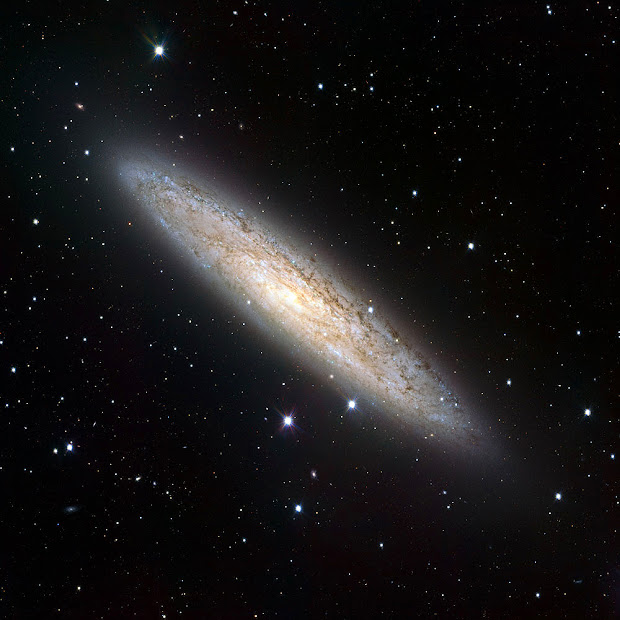Click on the image for full resolution (5.5 MB)
The VLT Survey Telescope (VST) has captured in sharp detail the beauty of the nearby spiral galaxy NGC 253. This new portrait is probably the best wide-field view of this object and its surroundings ever taken. It demonstrates that the VST, the newest telescope at ESO's Paranal Observatory, provides broad views of the sky while also offering impressive image quality. Luminous regions of ongoing star formation are spread throughout NGC 253, which is pumping out new stars at a furious pace. The data were processed using the VST-Tube system developed by A. Grado and collaborators at the INAF-Capodimonte Observatory. NGC 253 gleams about eleven and a half million light-years away in the southern constellation of Sculptor. It is often just called the Sculptor Galaxy, although other descriptive names include the Silver Coin or Silver Dollar Galaxy. It is easy to get a good look at NGC 253 through binoculars as it is one of the brightest galaxies in the sky after the Milky Way's closest, big galactic neighbour, the Andromeda Galaxy. Astronomers have noted the widespread active star formation in NGC 253 and labelled it a "starburst" galaxy. The many bright clumps dotting the galaxy are stellar nurseries where hot young stars have just ignited. The radiation streaming from these giant blue-white babies makes the surrounding hydrogen gas clouds glow brightly (green in this image). This nearby spiral galaxy was discovered by the German-British astronomer Caroline Herschel, the sister of the famed astronomer William Herschel, as she searched for comets in 1783. The Herschels would have been delighted by the crisp, richly detailed view of NGC 253 that the VST can provide. This latest image of NGC 253 was taken during VST's science verification phase - when the telescope’s scientific performance is assessed before it enters operations. The VST data are being combined with infrared images from VISTA to identify the younger generations of stars in NGC 253. This picture is more than 12 000 pixels across and the superb sky conditions at ESO's Paranal Observatory, combined with the fine telescope optics, result in sharp star images over the entire image.
The VST is a 2.6-meter wide-field survey telescope with a one-degree field of view - twice as broad as the full Moon. The VST programme is a joint venture between the INAF–Osservatorio Astronomico di Capodimonte, Naples, Italy and ESO. The 268-megapixel camera OmegaCAM at its heart is designed to map the sky both quickly and with very fine image quality. VST is the largest telescope in the world designed to exclusively survey the sky in visible light, complementing ESO's VISTA infrared survey telescope, also located at Paranal. Zooming into this new picture not only allows a very detailed inspection of the star-forming spiral arms of the galaxy to be made, but also reveals a very rich tapestry of much more distant galaxies far beyond NGC 253.
The full resolution image weighs 5.5 MB, so please be patient when downloading!
Credit:ESO/INAF-VST
Acknowledgement: A. Grado/L. Limatola/INAF-Capodimonte Observatory










0 comment(s):
Post a Comment